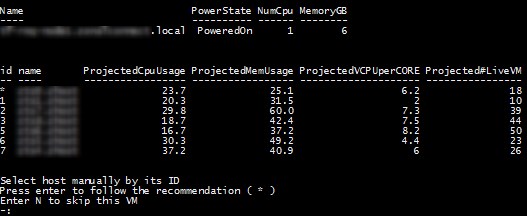Like many other places I believe, our non-prod hosts run on vSphere Standard instead of Enterprise Plus for its lower price. The price is great, but what isn’t is that DRS isn’t available. Which means every time a host needs to be put in maintenance mode you have to do it the old school way: manually vmotion all the VMs running on it.
My non-prod cluster has 9 hosts and 300 VMs. Although an option, the manual vMotion way is incredibly boring and time consuming.
In this post I am going to share a Powershell script that I quickly put together to automate the process of safely evacuating a host from the VMs running on it.
This script will safely migrate the VMs of a host one by one to other hosts by taking into consideration:
- Projected maximum CPU usage after migration (default 75%).
- Projected maximum Memory usage after migration (default 75%).
- Projected maximum vCPU per physical cores after migration (default 9).
- Possibility to exclude hosts from the possible destinations.
- Possibility to exclude VMs from the migratees.
- Interactive mode with possibility to change the selected destination host (default) or skip a VM.
- Fully automated mode.
- Possibility to use whatif.
If the resources requirements can’t be fulfilled, a warning is displayed and the VM is skipped.
The execution is pretty slow so I it’s something that can be improved. I don’t really mind as I fire it up and then I go do something else while it’s doing my job.
We could imagine adding a command to place the host in maintenance mode at the end of the script, but for now I don’t mind a right click.
Usage examples
Evacuate a host automatically with the default values (see above).
All the live VMs on ESXi-1 will be migrated to other hosts as long as they don’t go over 75% CPU/MEM usage and a 9:1 vCPU ratio.
Evacuate-VMHost -VMHost (Get-vmhost ESXi-1) -fullyautomated
Evacuate a host interactively with the defined values.
For every VM a choice will be given to the user including the projected capacity after the migration for every available host with a recommended one.
The user has 2 choices:
- Press enter and follow the script’s recommendation (the host with a *)
- Select another destination host
- Skip the VM and leave it where it is
Evacuate-VMHost -VMHost (Get-vmhost ESXi-1) -VMHostMaxCPUUsagePercent 80 -VMHostMaxMEMUsagePercent 85 -VMHostMaxVCpuPerCore 10

Parameters
- VMHost: Host to evacuate
- VMHostMaxCPUUsagePercent: CPU usage (%) limit that the destination hosts shouldn’t reach
- VMHostMaxMEMUsagePercent: Memory usage (%) limit that the destination hosts shouldn’t reach
- VMHostMaxVCpuPerCore: vCPU:core ration that the destination hosts shouldn’t reach
- ExcludedVMHost: Hosts to exclude from the possible destinations
- ExcludedVM: Virtual machines that won’t be migrated
- fullyAutomated: No choice given to the user, the VMs are migrated automatically one by one
- Whatif: Simulate the migration but doesn’t do it
Script code
Also available on github.
Function Evacuate-VMHost {
param (
[Parameter(Mandatory=$true,Position=0,ValueFromPipeline=$True,ValueFromPipelineByPropertyname=$True)]
[VMware.VimAutomation.ViCore.Types.V1.Inventory.VMHost]
$VMHost,
[ValidateRange(1,100)]
[int]
$VMHostMaxCPUUsagePercent = 75,
[ValidateRange(1,100)]
[int]
$VMHostMaxMEMUsagePercent = 75,
[int]
$VMHostMaxVCpuPerCore = 9,
[VMware.VimAutomation.ViCore.Types.V1.Inventory.VMHost[]]
$ExcludedVMHost,
[VMware.VimAutomation.ViCore.types.V1.Inventory.VirtualMachine[]]
$ExcludedVM,
[switch]
$fullyAutomated,
[switch]
$Whatif
)
Try {
IF ($VMHost.connectionstate -eq "connected") {
$VM = $VMHost | Get-VM | where {$_ -notin $ExcludedVM}
$VM | where powerstate -eq poweredon | ForEach-Object {
$CurVM = $_
$PossibleHost = Get-VMHost `
| Where name -ne $VMHost.name `
| where {$_ -notin $ExcludedVMHost} `
| where connectionstate -eq "connected" `
| where {(Compare-Object $CurVM.ExtensionData.network.value $_.ExtensionData.network.value).sideindicator -notcontains "<="}
$i = 0
$choice = "a"
$selectedVMHost = $PossibleHost | ForEach-Object {
$i++
$HostVM = $_ | get-vm | where powerstate -eq poweredon
[pscustomobject]@{
id = $i
name = $_.name
"ProjectedCpuUsage" = [math]::round(($_.CpuUsageMhz + $CurVM.ExtensionData.Runtime.MaxCpuUsage) / $_.CpuTotalMhz * 100,1)
"ProjectedMemUsage" = [math]::round(($_.MemoryUsageMB + $CurVM.memoryMB) / $_.MemoryTotalMB * 100,1)
"ProjectedVCPUperCORE" =[math]::round(($HostVM | Measure-Object -Property numcpu -Sum).sum / $_.NumCpu,1)
"Projected#LiveVM" = $HostVM.count + 1
}
} | where {$_.ProjectedCpuUsage -lt $VMHostMaxCPUUsagePercent -and $_.ProjectedMemUsage -lt $VMHostMaxMEMUsagePercent -and $_.ProjectedVCPUperCORE -lt $VMHostMaxVCpuPerCore}
IF ($selectedVMHost) {
$BestVMHost = $selectedVMHost | where id -eq ($selectedVMHost | select id,@{l="sum";e={$_.ProjectedCpuUsage + $_.ProjectedMemUsage}} | Sort-Object sum | select -First 1).id
($selectedVMHost | where id -eq $BestVMHost.id).id = "*"
IF (!$fullyAutomated) {
Clear-Host
$_ | select name,powerstate,numcpu,memorygb
$selectedVMHost | Sort-Object id | ft -au
Write-Host "Select host manually by its ID"
Write-Host "Press enter to follow the recommendation ( * )"
Write-Host "Enter N to skip this VM"
While ($choice -notin @("","n") -and $choice -notin (1..$i)) { $choice = Read-Host " " }
IF (!$Choice) {$selectedVMHost = $BestVMHost}
ELSEIF ($choice -eq "n") {Write-Warning "$($CurVM.name) skipped"}
ELSE {$selectedVMHost = $selectedVMHost | where id -eq $Choice}
} ELSE {
$selectedVMHost = $BestVMHost
}
IF ($choice -ne "n") {
Write-Host "$($CurVM.name) moving to $($selectedVMHost.name)" -ForegroundColor green
$params = @{VM = $_ ; Destination = get-vmhost $selectedVMHost.name}
IF ($Whatif) {$params.Add('whatif', $true)}
Move-VM @params | Out-Null
}
} ELSE {Write-Warning "There is no host capable of fulfilling the destination resource requirements"}
}
} ELSE {Write-warning "$($VMHost.name) is in a $($VMHost.connectionstate) state"}
} CATCH {
Write-Error $_.Exception -ErrorAction stop
}